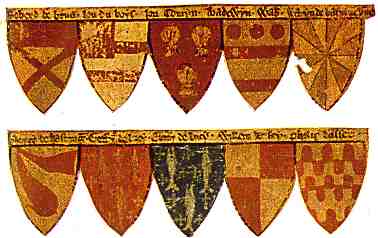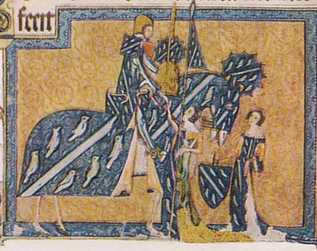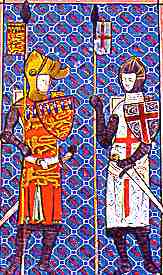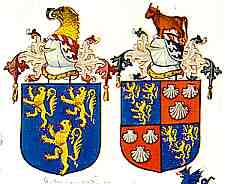 |
|
Works
on Heraldry (2) |
|
The
first recordings of heraldic motifs occur on heraldic rolls,
which appear from around 1250. These contain descriptions, as well as
illustrations, of the coats of arms of participants in tournaments or
battles. A long roll known as the Caerlaverock Roll records the shields of arms of the participants in the siege of Caerlaverock
Castle under Edward I in 1300. The individual descriptions, in Norman
French, indicate that a systematic vocabulary and syntax of heraldic
description has been developed by this time. The standard terms for heraldic
colours are there, along with descriptive terms such as cheverons,
bendes, label and lions passanz. It seems that the systematisation
of descriptive heraldic writing has been going on under the radar. |
| The earliest of these documents were produced by the heralds as a record rather than a granting of the coats of arms, initially recording the different shield designs associated with named knights. |
 |
Segment from the Heralds' Roll of Arms of c.1280 (College of Arms MS B.29). |
| The early coats of arms were relatively simple affairs with plain motifs in clear colours. The 14th century seems to have ushered in a greater complexity in the whole heraldic thing, with the additions of crests and mantlings, and supporters for those of very high social rank. Shields became more complex as the union by marriage of significant families was recorded by dividing up the shields. |
 |
| Segment of a genealogy of the Beauchamp family, drawn up in the late 15th or early 16th century, from a private collection. |
This segment of the genealogy shows the period around the end of the 13th century and beginning of the 14th. This much more humble document intersects with the Rous Roll shown below, as it concerns the Beauchamp family, one branch of which became Earls of Warwick for a time. It also shows the beginning of the transition to more complex heraldry as the simple shield of William Beauchamp, gules with a bend or (red with a gold stripe), was incorporated into the shields of each of his three sons, who each added elements derived from the coats of arms of their wives. The coronet above the shield of the next William Beauchamp, on the left, indicates his status as Earl of Warwick. Heraldry has become part of the vocabulary and syntax of genealogy. |
| As the arms themselves became more elaborate, with the addition of such appurtenances of helms with crests and mantling, so their recording by the heralds became more elaborate. By the 16th centuries, heralds were conducting visitations around the country to record the arms claimed by those entitled to them. By this time the ownership of arms had legal recognition, and some disputed cases had been tested in the courts in the 14th and 15th centuries. |
| Two coats of arms recorded in a Book of Visitation of 1531 (College of Arms MS D13, f.42b). |
|
 |
Heraldry ws employed in rolls recording the genealogies of significant families.The rather grotty illustration
at left shows a small section of the Rous Roll, produced in the late 15th
century, relating to the house of Warwick. The roll itself is actually
elaborate and splendid, showing the full elaboration of heraldic devices. |
|
Segment
of the Rous Roll (British Library, add. ms. 48976). |
|
Coats
of arms are also used in manuscripts
as symbols for, or references to, individuals. In this way they can act
as a record of heraldic devices. |
|
|
The
royal arms in the lower margin of the Historia Anglicorum of Matthew Paris (British Library, Royal 14 C VII), by permission of the
British Library. |
|
In
this autograph
manuscript, Matthew Paris has rendered the royal arms upside down
on the left hand page, to indicate that King John is dead, and turned
it right way up again on the right hand page for the beginning of the
reign of Henry III. This manuscript contains numerous coats of arms of
the participants in English history. |
|
|
Segment
from the order of proceedings for the coronation of Richard II (British
Library, Cotton Nero D VI, f.65v), by permission of the British Library. |
|
In
the example above, the shields of arms of various participants in the
coronation ceremony of Richard II are inserted beside the description
of their role: no doubt very helpful for the hapless soul who had to ensure
that everyone was in their place and doing the right thing at the right
time. |
| There was, however, no central authority in charge of regulating the whole affair. The king had his heralds, and so did other men of might. While they must have had some system of communication to ensure that there was no duplication, barons and bigwigs asserted the right to assign coats of arms to their own nearest and dearest. |
|
|
Letters
patent of Ralph, Baron Stafford of 1347, granting arms to his cousin Edmund
de Martayn (Eton College Library). |
|
The
above example of private letters
patent, written in Norman French in a cursive
script, assigns
a crest of a boar's head sable with dexter ear argent and a mantling sable
and wreath argent, together with a shield or badge of two colours, sable
with two bars argent. At least, that is how it would be described in formal
heraldic language, but the letter does use some plain French, such as
noyr and blank to describe colours. It is notable that this private sanction of the use
of arms includes not only the shield, but the elaborations of crest and
mantling that were becoming part of the whole process. |
 |
The
display of all this armorial stuff in privately commissioned manuscripts
was itself a form of the significata of rank and status. Sir Geoffrey
Luttrell is personally commemorated in his famous psalter
not for his good looks or piety, but for his ability to display a swanky coat
of arms all over himself, his horse, his womenfolk and the surrounding
landscape. |
|
Miniature
of Sir Geoffrey Luttrell with his horse, wife daughter and coat of arms,
from the Luttrell Psalter, f.202v, now in the British
Library. |
 |
Miniature of Edmund Crouchback (d.1296) Earl of Lancaster with St George in a book of hours of c.1295 (Bodleian Library, MS Douce 231). |
| The display of elaborate arms in such works as psalters or books of hours, themselves prestigious property for display, indicates the relationship between conspicuous displays of arms and social worth. The ownership of such prestigious books was itself a signifier of social worth. It also shows that information about arms may be found not only in manuscripts which specifically deal with the subject. |
| The
conspicuous display of arms was not only useful in battle for identification
purposes, it reinforced the proper social order. While born out of a feudal
conception, it later became an honorific system in a different society. |
|
continued
 |
 previous page
previous page |
 Categories
of Works Categories
of Works |
|
|
|
|
|
|
|
 |
 |
 |
 |
 |
 |







